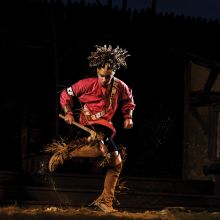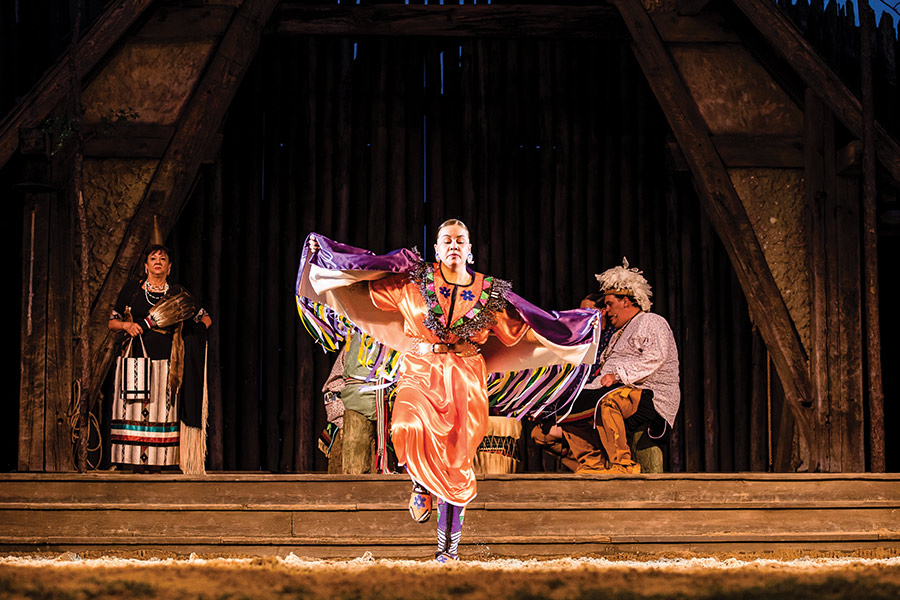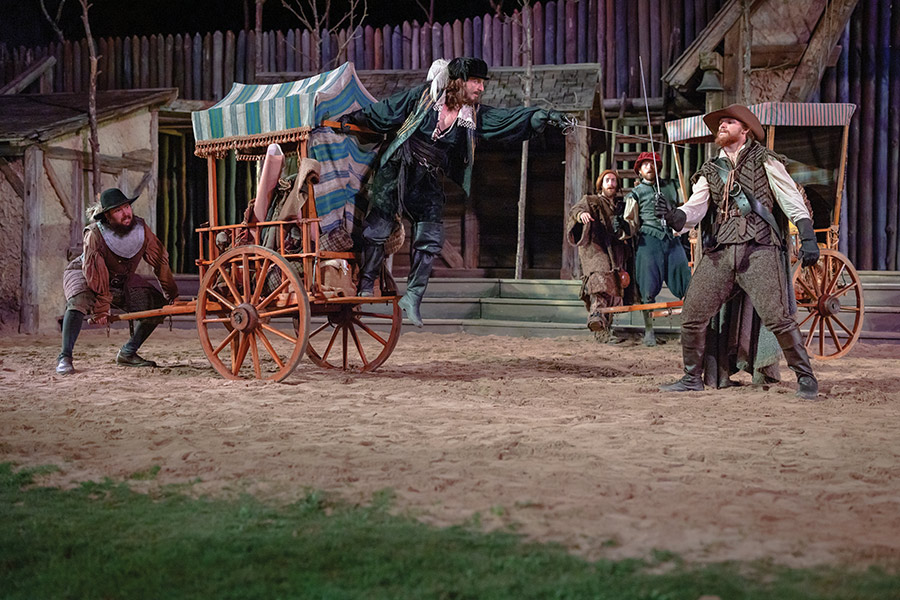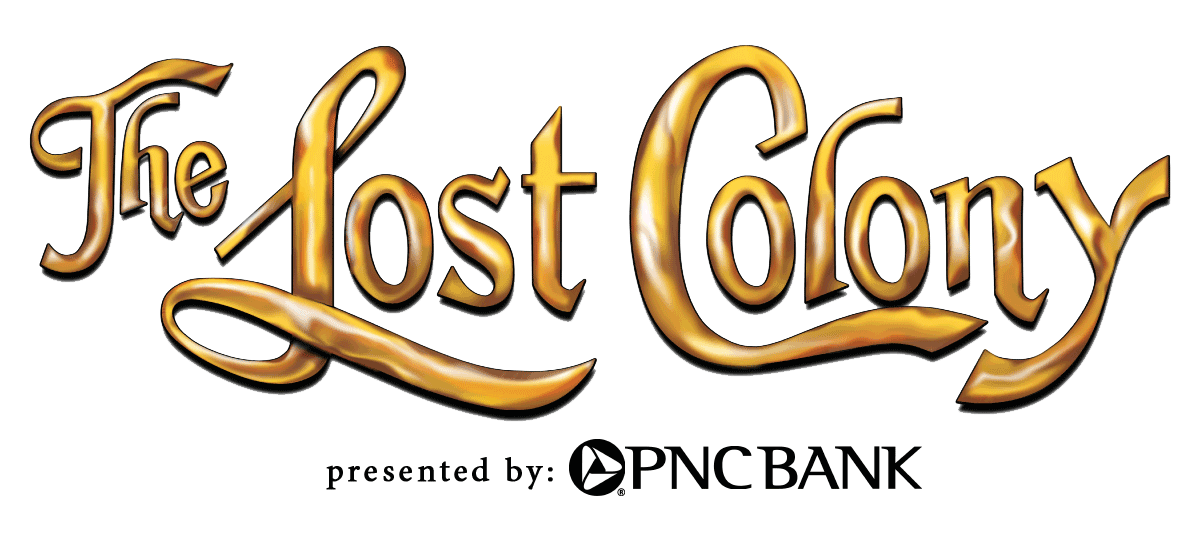Listen To This Article

For the 86th season of the popular and long-running outdoor drama The Lost Colony, Roanoke Island Historical Association, Director and Choreographer Jeff Whiting and a talented team of theater professionals have managed to bring an undeniable touch of Broadway flair and excitement to an historic production.
With a restructured script and updated choreography, score and staging, this beloved classic is thriving in its latest incarnation. It’s a winning mix – the new elements add excitement and pizazz, while the heart and intent of the story remain steadfast and strong.
“Audiences will get to experience the show they know and love in a brand-new way,” Whiting assures.
Inherently full of plot and drama, The Lost Colony is the intriguing story of the 1587 attempt to establish an English settlement in the New World. As the settlers set up their colony on Roanoke Island, Virginia Dare, the first English child born in the New World, arrived, but altogether things were not going well. The colonists were struggling to gain a foothold and sparring with the native inhabitants of the land. Some members of their colony sailed back to England to gather more supplies, but before they could return, England went to war with Spain, and Queen Elizabeth would not allow any ships to sail to the New World. Three years later, when they finally returned to Roanoke Island with supplies, they found the colony had vanished. Virginia Dare and the other colonists were never found.

Eighty-six years ago, Paul Green wrote the script of this story for The Lost Colony for a one-night celebration of Virginia Dare’s birthday. The play was so successful that Green staged it again the following year and again the next until it became an annual staple performance on Roanoke Island. Green remained involved until 1974, rewriting and updating the script as needed.
The outdoor drama, which won a Tony Award in 2013, is full of pageantry, dancing, fight scenes, drama, music and comedy that make it popular with all ages. The outdoor setting provides a fun family environment, and the play gets tons of return viewers. When the pandemic and the accompanying shutdowns arrived in 2020, the board of directors decided to follow Green’s lead on updating the tradition of The Lost Colony and use the time to reinvigorate the show.

Enter Whiting, a director and choreographer who has worked on such Broadway shows as Young Frankenstein, Big Fish, Bullets over Broadway, Hair and many, many more. He brings extensive theatrical experience to The Lost Colony.
Whiting recognizes the importance of honoring the original play while at the same time reinvigorating it.
“My main task was to make sure it landed visually and emotionally with modern-day audiences,” Whiting says.
The play was originally written in 1937, so some of the dialogue needed updating in order to be respectful of Native American culture. Whiting hired Tony-nominated writer David Thompson to help shape the story while maintaining Paul Green’s script for the new production. Originally told from only the colonists’ point of view, the new script offers a shift to include the perspective of the Native Americans involved in the story. In addition, every actor playing a Native American role is now an indigenous person.
The Roanoke Island Historical Association Board initiated a partnership with the Lumbee tribe, and Whiting coordinated with them to make sure the play is respectful of Native American culture. Their working relationship ended up being fruitful to the reimagining of some of the visual elements of the show.

“I was talking with the then-chairman of the Lumbee tribe, and he compared the violence between the settlers and Native Americans to bears and wolves that sometimes don’t get along,” Whiting says. “I thought, ‘What if we depicted the play’s violence in a theatrical way, as a parable, with bears and wolves fighting? Whiting hired New York designer Nicholas Mahon to create theatrical puppets that begin the play resembling trees in the scenery and then magically transform to become bears, elk and wolves.
One plot point occurs when some of the colonists kill the leader of one of the Native American tribes. Instead of depicting this as a physical fight scene, Whiting shifts the actors to puppets, and the bears and wolves carry out the fight. The result is both visually arresting and dramatically striking.
The visual aspects of The Lost Colony have always been impactful, with the plot naturally lending itself to dance and pageantry. Whiting has updated the play’s dance elements to feature authentic Native American dances, hiring Native American choreographer Nakya Leviner, who also performs in the show, to ensure the dance is authentic and culturally respectful.
Another big change Whiting made is with its theatrical staging, adding compelling movement which drives the action of the play forward and simultaneously adds visual spectacle. This updates the play in its visual aspects without changing the original dialogue or plot. For example, when Queen Elizabeth makes her entrance, Whiting designed new choreography and design elements with waving flags that ring of pomp and royalty.

Technology is another element that Whiting is introducing into the visual elements of The Lost Colony, bringing 3D-mapped projections to the theater. Instead of projecting on a screen, the 3D projections are seen on the scenery, almost magically transporting the audience from Roanoke Island's Waterside Theatre to the English garden of Queen Elizabeth I. They are able to turn the entire stage into the ocean during one part of the show so the audience can witness the ships arriving from England during a storm. The Lost Colony’s 3D projection designer, Christopher Ash, played a prominent role in the Broadway show New York, New York, which is currently nominated for a Tony in Best Scenic Design.
The Lost Colony is known as a symphonic drama but previously lacked a full score. Whiting hired composer Sam Davis, who is currently nominated for a Tony award, to write a symphonic score that provides an added auditory element to the play. The score features not only traditional songs and old English tunes, but also a composition that symphonically underscores the action of the play. The Lost Colony recently received a grant to purchase the sound system used to broadcast Davis’ score throughout the theater.

By all accounts, Whiting’s updates are landing well with audiences. Multiple reviews written by audience members express that it was the best thing they did on vacation, that children loved the show and that they have attended for multiple years in a row and plan to continue that tradition.
And that’s because The Lost Colony is a true Outer Banks story and a much-loved and longstanding tradition.
“I think one thing that’s important to note is that although we’ve reimagined the show, we haven’t changed the plot or the show itself,” Whiting says. “It was very important for us to honor the original show. The reinvention has been primarily in modernizing the staging, the visual aspect and the music.”
86th Season of The Lost Colony
June 2 to August 26
Monday through Saturday 8:30 p.m.
Tickets: $25 to $40
Pre-Show Native American Cultural Presentations: Tuesdays, Fridays and Saturdays at 8 p.m. (included in ticket price)
Backstage Tours: Nightly 7:30 p.m. (additional cost, $15)
For tickets and more information, go to thelostcolony.org or call (252) 473-6000
www.thelostcolony.org
Ticket Office: (252) 473-6000
Administration: (252) 473-2127
1409 National Park Drive
Manteo, NC 27954



 Heather Frese fell in love with the Outer Banks when she was three years old. She grew up camping every summer on Hatteras Island, and her writing is deeply influenced by the history and wild beauty of the area. Her debut novel, The Baddest Girl on the Planet, won the Lee Smith Novel Prize and is set on Hatteras Island.
Heather Frese fell in love with the Outer Banks when she was three years old. She grew up camping every summer on Hatteras Island, and her writing is deeply influenced by the history and wild beauty of the area. Her debut novel, The Baddest Girl on the Planet, won the Lee Smith Novel Prize and is set on Hatteras Island. 




